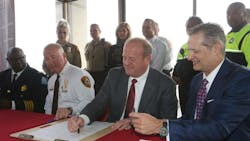Regional leaders sign St. Louis Metro Transit security agreement
St. Louis Metro has signed a new security agreement along with its regional partners that outlines the framework for providing transit riders with a safer, more secure and more comfortable ride.
This agreement is the culmination of two years of work and collaboration between St. Louis Metro Transit, Bi-State Development, East-West Gateway Council of Governments, WSP, St. Louis County, city of St. Louis, St. Clair County and St. Louis Metro’s law enforcement partners at St. Louis County Police Department, St. Clair County Sheriff’s Department and the Metropolitan St. Louis Police Department.
“Building strong regional partnerships are the keys to ensuring a safe and secure public transit system,” said Taulby Roach, president and CEO of Bi-State Development. “Our customers will experience a more cohesive and coordinated approach to security that will offer an improved transit experience.”
What St. Louis Metro Transit security looks like today
There are multiple layers of security and personnel patrolling the system and helping passengers:
Security officers and fare inspectors assist passengers; patrol trains, MetroLink stations and transit centers; and enforce the rules and policies of the St. Louis Metro Transit system.
Transit security specialists support security officers and other St. Louis Metro team members while patrolling the system, responding to calls and coordinating with law enforcement.
Law enforcement partners at St. Louis County Police Department, St. Louis Metropolitan Police Department, St. Clair County Sheriff’s Department and St. Louis City Sheriff’s Department provide a uniformed police presence on the transit system with both full-time and part-time officers and deputy sheriffs.
The hiring of a new public safety leadership team last year has helped accelerate St. Louis Metro’s transition into a new public safety strategy. To deliver a safe and comfortable ride to customers, the agency is focused on three key areas:
Visibility: Transit security specialists and security officers are everywhere the customers are — patrolling platforms, at transit centers, on board MetroBus and MetroLink trains. With new, high-visibility uniforms, they are easy to spot and are always ready to assist.
Rule Enforcement: Loud music and smoking are examples of nuisance behavior that can create a negative experience for all riders. Our team is strengthening enforcement of the rules of the transit system to ensure everyone is using St. Louis Metro the right way and can enjoy a safe, comfortable commute.
Technology and Infrastructure: All MetroLink platforms are monitored on video 24/7 by dispatchers who can immediately call for security or law enforcement assistance if necessary. Cameras also monitor Park-Ride lots, stairwells, parking facilities and trains, buses and vans. St. Louis Metro is also using new infrastructure to create better monitored and secure access points to the transit system.
Ongoing improvements
At the same time the comprehensive security strategy has been developed over the past two years, St. Louis Metro has been making significant improvements to its public safety approach.
In the past two months, Metro Transit has approved new contracts and agreements with regional law enforcement partners and with the new contracted security provider – G4S Secure Solutions – who will being providing contract security guard services beginning in April. The new guards will be wearing new high-visibility uniforms, which were adopted by transit security specialists in January, which will provide a more visible and accessible security presence.
In addition, last fall St. Louis Metro expanded a pilot project that changes how customers access platforms. Initially launched in September 2018, the program employed new infrastructure and personnel to create new, defined access points to the North Hanley, Forest Park-DeBaliviere and Fairview Heights Transit Centers, with the goal of improving fare inspection and customer experience. The overwhelmingly positive feedback received from customers, law enforcement and security personnel led to the expansion of this project to the Central West End and Delmar Loop Transit Centers.
Comprehensive security strategy
The security strategy can be read in its entirety on East-West Gateway’s website. It has four major goals:
- To reduce the rate and perception of crime on the St. Louis Metro system;
- To implement fare enforcement as a security tool;
- To engage all St. Louis Metro employees and security contractors in securing the Metro system; and
- To identify and assess crime and other security threats to customers, employees and property and to maximize security effectiveness.
The foundation of this strategy is a St. Louis Metro Security Assessment launched in Spring 2018, performed in conjunction with East-West Gateway, regional law enforcement and security consultant WSP-USA.
